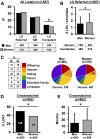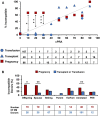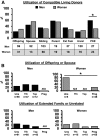Pregnancy-Induced Sensitization Promotes Sex Disparity in Living Donor Kidney Transplantation
- PMID: 28483798
- PMCID: PMC5619956
- DOI: 10.1681/ASN.2016101059
Pregnancy-Induced Sensitization Promotes Sex Disparity in Living Donor Kidney Transplantation
Abstract
The presence of sex disparity in living donor kidney transplantation (LDKT) remains controversial. To determine if women fall behind men in LDKT evaluation, we performed an intention to treat study of 2587 candidates listed for kidney transplant at a single transplant center over 7 years. We found that women and men kidney transplant candidates engaged an equivalent type and number of prospective living donors. However, sex-specific differences in sensitization history and histocompatibility reduced the rate of LDKT for women by 30%. Pregnancy-induced incompatibility with spouse donors was limiting given that spouses were among the individuals most likely to complete donation. Notably, participation in a kidney paired exchange program eliminated sex-based differences in LDKT. Collectively, these data suggest that pregnancy is a formidable biologic barrier for women and contributes uniquely to sex disparity in LDKT. Targeted efforts to improve transplant center participation in paired kidney exchanges may increase sex equity in LDKT.
Keywords: disparity; gender difference; kidney donation; kidney transplantation; pregnancy.
Copyright © 2017 by the American Society of Nephrology.
Figures




Comment in
-
Sex and Kidney Transplantation: Why Can't a Woman Be More Like a Man?J Am Soc Nephrol. 2017 Oct;28(10):2829-2831. doi: 10.1681/ASN.2017060657. Epub 2017 Jul 28. J Am Soc Nephrol. 2017. PMID: 28754789 Free PMC article. No abstract available.
Similar articles
-
Center-level factors and racial disparities in living donor kidney transplantation.Am J Kidney Dis. 2012 Jun;59(6):849-57. doi: 10.1053/j.ajkd.2011.12.021. Epub 2012 Feb 25. Am J Kidney Dis. 2012. PMID: 22370021
-
Mitigating Racial and Sex Disparities in Access to Living Donor Kidney Transplantation: Impact of the Nation's Longest Single-center Kidney Chain.Ann Surg. 2019 Oct;270(4):639-646. doi: 10.1097/SLA.0000000000003484. Ann Surg. 2019. PMID: 31348035 Free PMC article.
-
Gender disparity in living renal transplant donation.Am J Kidney Dis. 2000 Sep;36(3):534-40. doi: 10.1053/ajkd.2000.9794. Am J Kidney Dis. 2000. PMID: 10977785
-
Living Donor Kidney Transplantation: Improving Education Outside of Transplant Centers about Live Donor Transplantation--Recommendations from a Consensus Conference.Clin J Am Soc Nephrol. 2015 Sep 4;10(9):1659-69. doi: 10.2215/CJN.00950115. Epub 2015 Jun 26. Clin J Am Soc Nephrol. 2015. PMID: 26116651 Free PMC article.
-
Gender-specific differences associated with living donor liver transplantation: a review study.Liver Transpl. 2010 Mar;16(3):375-86. doi: 10.1002/lt.22002. Liver Transpl. 2010. PMID: 20209639 Review.
Cited by
-
Mechanisms and consequences of sex differences in immune responses.Nat Rev Nephrol. 2024 Jan;20(1):37-55. doi: 10.1038/s41581-023-00787-w. Epub 2023 Nov 22. Nat Rev Nephrol. 2024. PMID: 37993681 Review.
-
Sociodemographic Drivers of Donor and Recipient Gender Disparities in Living Kidney Donation in Australia.Kidney Int Rep. 2023 May 26;8(8):1553-1561. doi: 10.1016/j.ekir.2023.05.016. eCollection 2023 Aug. Kidney Int Rep. 2023. PMID: 37547516 Free PMC article.
-
Gender disparities in transplantation.Curr Opin Organ Transplant. 2021 Oct 1;26(5):513-520. doi: 10.1097/MOT.0000000000000909. Curr Opin Organ Transplant. 2021. PMID: 34343154 Free PMC article. Review.
-
Fully Understanding Sex/Gender Disparities in Kidney Care Requires End-to-End, National Data Collection.Kidney Int Rep. 2024 May 18;9(7):1951-1953. doi: 10.1016/j.ekir.2024.05.017. eCollection 2024 Jul. Kidney Int Rep. 2024. PMID: 39081749 Free PMC article. No abstract available.
-
Few Gender Differences in Attitudes and Experiences after Live Kidney Donation, with Minor Changes Over Time.Ann Transplant. 2017 Dec 29;22:773-779. doi: 10.12659/aot.906129. Ann Transplant. 2017. PMID: 29284769 Free PMC article.
References
-
- Matas AJ, Smith JM, Skeans MA, Thompson B, Gustafson SK, Schnitzler MA, Stewart DE, Cherikh WS, Wainright JL, Snyder JJ, Israni AK, Kasiske BL: OPTN/SRTR 2012 annual data report: Kidney. Am J Transplant 14[Suppl 1]: 11–44, 2014 - PubMed
-
- Roodnat JI, van Riemsdijk IC, Mulder PG, Doxiadis I, Claas FH, IJzermans JN, van Gelder T, Weimar W: The superior results of living-donor renal transplantation are not completely caused by selection or short cold ischemia time: A single-center, multivariate analysis. Transplantation 75: 2014–2018, 2003 - PubMed
-
- Chkhotua AB, Klein T, Shabtai E, Yussim A, Bar-Nathan N, Shaharabani E, Lustig S, Mor E: Kidney transplantation from living-unrelated donors: Comparison of outcome with living-related and cadaveric transplants under current immunosuppressive protocols. Urology 62: 1002–1006, 2003 - PubMed
-
- Rodrigue JR, Kazley AS, Mandelbrot DA, Hays R, LaPointe Rudow D, Baliga P; American Society of Transplantation : Living donor kidney transplantation: Overcoming disparities in live kidney donation in the US-recommendations from a consensus conference. Clin J Am Soc Nephrol 10: 1687–1695, 2015 - PMC - PubMed
-
- Gore JL, Danovitch GM, Litwin MS, Pham PT, Singer JS: Disparities in the utilization of live donor renal transplantation. Am J Transplant 9: 1124–1133, 2009 - PubMed
MeSH terms
LinkOut - more resources
Full Text Sources
Other Literature Sources
Medical

